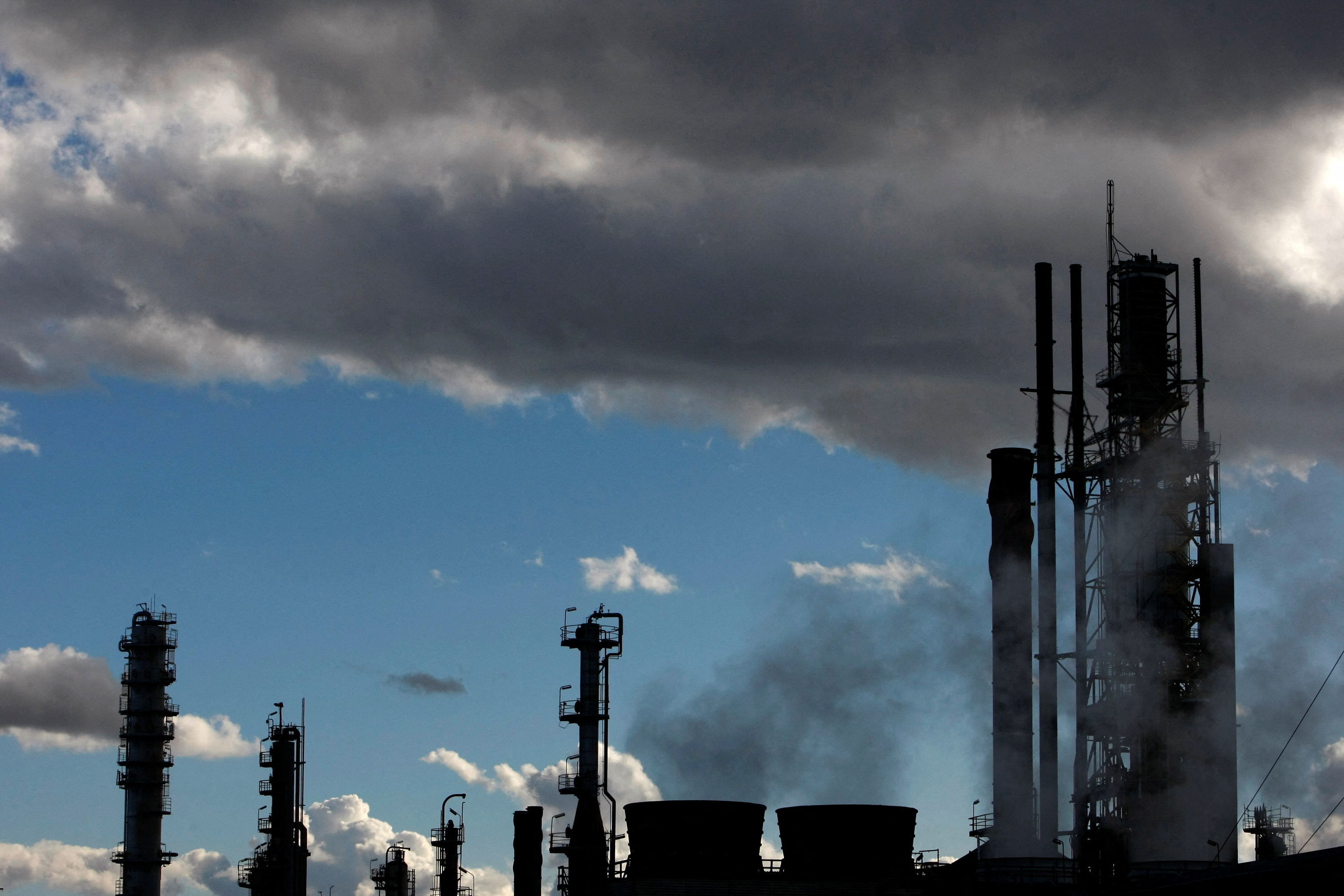
Steam and other emissions are seen coming from funnels at an oil refinery in Melbourne June 24, 2009. REUTERS/Mick Tsikas
Feb 8 (Reuters) – The world’s top oil and gas companies have set varying targets to reduce greenhouse gas emissions from their operations and the use of the products they sell.
Some companies, including BP, Norway’s Equinor and Spain’s Repsol, aim to reduce some or eliminate all of their emissions in absolute terms by 2050.
Others, including Total, are focusing on reducing the carbon intensity of their operations and products.
Intensity-based targets measure the amount of greenhouse gas (GHG) emissions, such as methane and carbon dioxide per unit of energy or barrel of oil and gas produced. That means absolute emissions can rise with growing production, even if the headline intensity metric falls.
Reducing emissions will require a well-functioning market for carbon, the scaling up of carbon capture and storage technology and the development of competitive uses of hydrogen, many of the companies have said.
The table below shows details by company (in alphabetical order):
|
Targets
|
Scope 1
|
Scope 2
|
Scope 3
|
Link to exec. pay
|
Details
|
|
BP
|
yes
|
yes
|
yes
|
yes
|
Bring net GHG emissions from operations, production and sales to zero by 2050
Reduce operational emissions by 50% by 2030 |
|
Chevron
|
yes
|
yes
|
yes(not net zero)
|
yes
|
Targets net zero emissions from Scope 1 and 2 from its equity output by 2050
>5% reduction in carbon emission intensity, including Scope 3, by 2028 vs 2016 Reduce methane intensity by 50% by 2028; zero routine flaring by 2030 read more |
|
ConocoPhillips
|
yes
|
yes
|
no
|
Reduce GHG emissions intensity by up to 15% (CO2e per boe) by 2030 per boe vs 2017 levels
|
|
|
Eni
|
yes
|
yes
|
yes
|
yes
|
Reduce absolute emissions to net zero by 2050; by 25% by 2025 and by 65% by 2040
Targets includes products purchased from third parties read more |
|
Equinor
|
yes
|
yes
|
yes
|
yes
|
Reduce net GHG emissions to zero by 2050, including Scope 3 emissions from customers’ use of Equinor’s equity production volumes
Reduce upstream CO2 per boe produced to below 8 kg by 2025 Achieve carbon neutral global operations by 2030 Reducing absolute greenhouse gas emissions from operated fields and onshore plants in Norway towards net zero by 2050 without offsets To ensure no routine flaring and near zero methane emissions by 2030 Reduce net carbon intensity to zero by 2050 |
|
Exxon
|
yes
|
yes
|
no
|
yes
|
Reach net zero for Scope 1 and 2 emissions by 2050
Reduce methane emissions intensity by 40% to 50% versus 2016 levels by 2025 Performance share award pay tied to managing risks related to climate change. |
|
Repsol
|
yes
|
yes
|
yes
|
yes
|
Reduce net carbon emissions to zero by 2050 (incl. Scope 3 from own barrels produced)
Reduce carbon intensity vs 2016 by 15% by 2025 (per gigajoule), 28% by 2030, 55% by 2040 Reduce absolute emissions from operated assets (Scope 1 and 2) by 55% and net emissions by 30% (incl. Scope 3 from own barrels produced) by 2030 Reduce methane intensity by 85% by 2025 |
|
Shell
|
yes
|
yes
|
yes
|
yes
|
Reduce Scope 1 and 2 emissions from operated assets by 50% by 2030 vs 2016 in absolute terms
Reduce net carbon footprint (an intensity-based measure of carbon emitted per energy unit) vs 2016 baseline of all products sold by at least 6% by 2023, by 20% by 2030, by 45% by 2035 and by 100% by 2050 (incl. Scope 3 from products not produced but sold by Shell) 120 mln t nature-based offsets a year by 2030 25 mln t carbon capture and storage capacity a year by 2035 read more |
|
Total
|
yes
|
yes
|
yes
|
yes
|
Worldwide Scope 3 emissions lower in 2030 vs 2015
Overall Scope 1, 2, 3 emissions intensity reduction by at least 60% by 2050 40% reduction in its Scope 1 and 2 emissions in 2030 compared to 2015 Overall Scope 1, 2 emissions to net zero by 2050 European Scope 1, 2, 3 emissions down 30% by 2030 in absolute terms, 100% by 2050 Five mln tonnes/year of carbon sinks by 2030 Methane intensity targets |
NOTE: 1) Scope 1 refers to emissions from a company’s direct operations, such as a diesel generator on an offshore platform
2) Scope 2 are emissions from the power a company uses for its operations, such as gas-powered electricity purchased
3) Scope 3 includes emissions from products sold, such as gasoline sold at petrol stations or jet fuel sold to an airline
4) BOE stands for barrels of oil equivalent
Share This:




 CDN NEWS |
CDN NEWS |  US NEWS
US NEWS 




























Trump Is Scaring Republicans Away From Saving the Planet